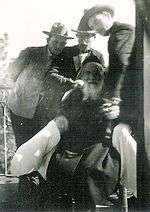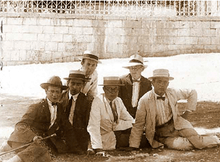Hebron Yeshiva

Hebron Yeshiva, also known as Yeshivas Hevron, or Knesses Yisroel, is a yeshiva devoted to high-level study of the Talmud. It originated in 1924 when the roshei yeshiva and 150 students of the Slabodka Yeshiva, known colloquially as the "mother of yeshivas", relocated to Hebron.
Relocation of Slabodka Yeshiva to Palestine

A 1924 edict requiring enlistment in the military or supplementary secular studies in the yeshiva led a large number of students in the Slabodka yeshiva to relocate to Palestine. Rabbi Nosson Tzvi Finkel, also known as "Der Alter fun Slabodka" (The Elder of Slabodka), sent Rabbi Avraham Grodzinski to head this group and establish the yeshiva in Hebron.[1] Upon Grodzinski's return to Slabodka, the Alter transferred the mashgiach ruchani responsibilities to him, and the rosh yeshiva duties to Rabbi Yitzchok Isaac Sher, and he moved to Hebron to lead the yeshiva there together with Rabbi Moshe Mordechai Epstein.[2] Hebron was chosen over Jerusalem to avoid the influence of the Conservative Old Yishuv. The Slabodka yeshiva in Europe ceased operation during the Holocaust. A branch was also established in Bnei Brak.
1929 Hebron massacre and relocation to Jerusalem

Twenty-four students were murdered in the 1929 Hebron massacre, and the yeshiva was re-established in the Geula neighbourhood of Jerusalem. Despite a delay after the death of Rabbi Moshe Hebroni, the last of the previous generation, the yeshiva moved into a new and larger campus in the south-central Givat Mordechai neighbourhood in 1975. This yeshiva today has about 1300 students and is one of the most prestigious and influential Lithuanian yeshivohs in Israel. The current roshei yeshiva are Rabbi Dovid Cohen[3] and Rabbi Yosef Chevroni.
Prominent alumni

- Meyer Abovitz, av beis din in Russia
- Yehuda Amital, rosh yeshiva, Yeshivat Har Etzion
- Menachem Mendel Blachman, Rosh yeshivas kerem beyavneh
- Zvi Block, Talmudic instructor, Mir yeshiva (Brooklyn)
- Menachem Elon, the former Deputy Chief Israeli Supreme Court
- Baruch Mordechai Ezrachi, rosh yeshiva, Yeshiva Ateres Yisrael, Jerusalem
- Shlomo Goren, Ashkenazi Chief Rabbi of Israel
- Rene Gutman, Chief Rabbi, Strasbourg
- Yeshayahu Hadari, rosh yeshiva, Yeshivat Hakotel
- Yitzchok Hutner, rosh yeshiva, Yeshiva Rabbi Chaim Berlin
- Shneur Kotler, rosh yeshiva, Beth Medrash Govoha
- Dov Landau, rosh yeshiva, Slabodka yeshiva (Bnei Brak)
- Sholom Schwadron, Haredi rabbi and maggid
- Dov Schwartzman, rosh yeshiva, Yeshivas Beis HaTalmud
- Avraham Shapira, rosh yeshiva, Mercaz HaRav
- Yitzhak Yosef, Sepharadi Chief Rabbi of Israel
See also
| Wikimedia Commons has media related to Hebron Yeshiva Knesseth Israel. |